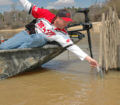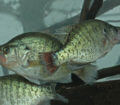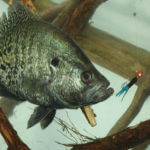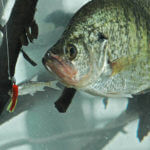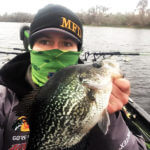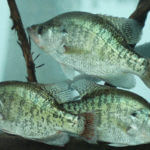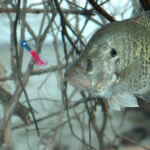Editor’s Note: The spring flood threat all over the U.S. continues to rise – particularly in the East and the Midwest with their still-growing snow packs. The National Weather service predicts at least a 50% chance of flooding throughout May due to the Midwest and mountains in the West having their snowiest February on record. One of the problems, according to the NWS is the wet summer and fall of 2018, plus the wettest winter (December-February) in records kept since 1895. So, John in the Wild (JITW) knew you needed to learn to fish for crappie under flood-water conditions. Here’s a link to a map giving more information: https://weather.com/safety/floods/news/2019-03-08-major-spring-flood-threat-midwest-new-england-march-update. JITW interviewed nationally-known tournament crappie fisherman and guide Jonathan Phillips of Wetumpka, Alabama.
 Here in my home state of Alabama, several lakes and rivers well-known for their crappie fishing have flooded out of their banks in February, 2019 – sometimes 6-8 feet deep – and caused millions of dollars of damage at Weiss Lake, Smith Lake and the Tombigbee River. The day before I fished with Jonathan Phillips on this trip, the Alabama River where he fishes had 7 inches of rain, and the river was up past full pool. I asked him how and where he finds and catches crappie under flood-water conditions.
Here in my home state of Alabama, several lakes and rivers well-known for their crappie fishing have flooded out of their banks in February, 2019 – sometimes 6-8 feet deep – and caused millions of dollars of damage at Weiss Lake, Smith Lake and the Tombigbee River. The day before I fished with Jonathan Phillips on this trip, the Alabama River where he fishes had 7 inches of rain, and the river was up past full pool. I asked him how and where he finds and catches crappie under flood-water conditions.
When you have flood waters like this, finding and catching crappie can become complicated. Many of the locations that have held crappie before the flood won’t home crappie when flood water hits, because the ambush points where crappie normally hold on structure will not be as productive feeding spots as eddies and backwashes. However, if you learn to fish the eddies and backwashes, you often can have a crappie fishing trip of a lifetime during floods. I don’t consider fishing flood-water crappie as easy fishing, but if you find the crappie, those trips will be trips to remember.
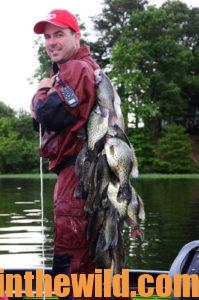 You really have to study the flooded water before you fish. Usually, a lot of debris will be on the river or in the lake. Search for debris that’s moving the opposite way of the current, because this event usually denotes an eddy hole, and the baitfish generally will hold off the current in those eddy holes. Of course, the baitfish attract the crappie, but the crappie aren’t the only fish holding in those eddy holes. Bass, catfish, white bass and other bass also will be concentrating in or off of those eddy holes. Oftentimes, the crappie won’t be holding on any type of structure but will be suspended.
You really have to study the flooded water before you fish. Usually, a lot of debris will be on the river or in the lake. Search for debris that’s moving the opposite way of the current, because this event usually denotes an eddy hole, and the baitfish generally will hold off the current in those eddy holes. Of course, the baitfish attract the crappie, but the crappie aren’t the only fish holding in those eddy holes. Bass, catfish, white bass and other bass also will be concentrating in or off of those eddy holes. Oftentimes, the crappie won’t be holding on any type of structure but will be suspended.
For more information, contact Jonathan Phillips at 334-391-9735 or jphillips10482@yahoo.com, or go to his Facebook page at https://www.facebook.com/Team-Phillips-Guide-Service-935028296557829.

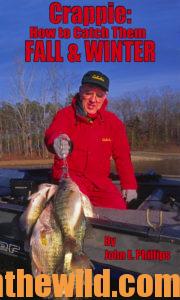
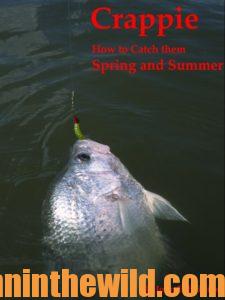 For more tips and information on catching crappie, check out John E. Phillips’ Kindle and print books “Crappie: How to Catch Them Fall and Winter” and “Crappie: How to Catch Them Spring and Summer,” also available from Audible at https://www.audible.com/pd/B06XTV9J2F/?source_code=AUDFPWS0223189MWT-BK-ACX0-083098&ref=acx_bty_BK_ACX0_083098_rh_us. Or, go to http://www.amazon.com/John-E.-Phillips/e/B001HP7K6O to see all of John’s books. To receive and download for free “The Crappie Catchers’ Cookbook,” by John and Denise Phillips, go to https://www.dropbox.com/sh/1tvp5nmxp8jycjf/AAAiOTM6vHolzGV44kO2oEnKa?dl=0.
For more tips and information on catching crappie, check out John E. Phillips’ Kindle and print books “Crappie: How to Catch Them Fall and Winter” and “Crappie: How to Catch Them Spring and Summer,” also available from Audible at https://www.audible.com/pd/B06XTV9J2F/?source_code=AUDFPWS0223189MWT-BK-ACX0-083098&ref=acx_bty_BK_ACX0_083098_rh_us. Or, go to http://www.amazon.com/John-E.-Phillips/e/B001HP7K6O to see all of John’s books. To receive and download for free “The Crappie Catchers’ Cookbook,” by John and Denise Phillips, go to https://www.dropbox.com/sh/1tvp5nmxp8jycjf/AAAiOTM6vHolzGV44kO2oEnKa?dl=0.

